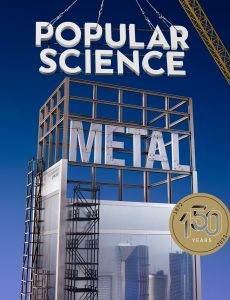
Popular Science USA – Summer 2022
English | 82 pages | pdf | 22.43 MB
Welcome at Popular Science USA Magazine Summer 2022 Issue
I’VE BEEN somewhat dreading picking a theme for this issue, the 150th-anniversary edition of PopSci, almost since the day I took the chair as editor-in-chief a little more than two years ago. How could one hope to encapsulate a history so deep and broad as to be punctuated by the earliest telephones, the development of the polio vaccine, and the rollout of WiFi?
Sure, all these things—and the literal thousands of other inventions that have appeared in our pages—have common threads in research and innovation, but words like that are the low-hanging fruit. They’re our DNA, as opposed to a discrete thought. What could possibly bring all this to a head in a tangible way? The answer, oddly enough, was a theme the editors have batted around for years: metal.
Eras of human technological development have been defined by metals (copper, bronze, then iron). And that relationship has only become more intricate and intimate with time. An early typewriter, for example, contained only a few distinct metals, including steel and zinc. The laptop I’m using right now contains no fewer than 19 of the conductive elements, from everyday substances like aluminum to precious commodities like gold.
But this issue isn’t about taking a navel-gazing hike through history— it’s about defining the metallic moment we’re in right now.
The crux of our modern tug-of-war with the periodic table is the rush toward electrification. All those turbines, charging stations, and batteries put new pressure on natural resources, even as they ease the old burdens of fossil fuel use. So the centerpiece of this issue is a series of stories focusing on the pinch points in our quest to decarbonize:
We explore the challenges of environmentally conscious mining by way of Idaho’s first new cobalt extraction operation in 40 years; visit a lab whose process for purifying copper could spell an end to noxious smelting; and check in on a startup aiming to close the loop on EV batteries through novel recycling techniques.
Responsibly and carefully mastering metal (perhaps, we posit, even of the Ozzy Osbourne variety) is the key to unlocking our future. And understanding it—as NASA hopes to do by visiting an asteroid that’s a possible analogue of Earth’s own heart—can help us comprehend our own journey. That’s as grand a thought as I could hope for as we celebrate this magazine’s sesquicentennial and look forward to the next 150 years.
Download from: